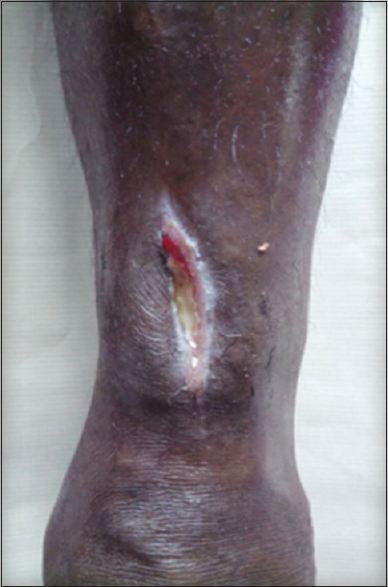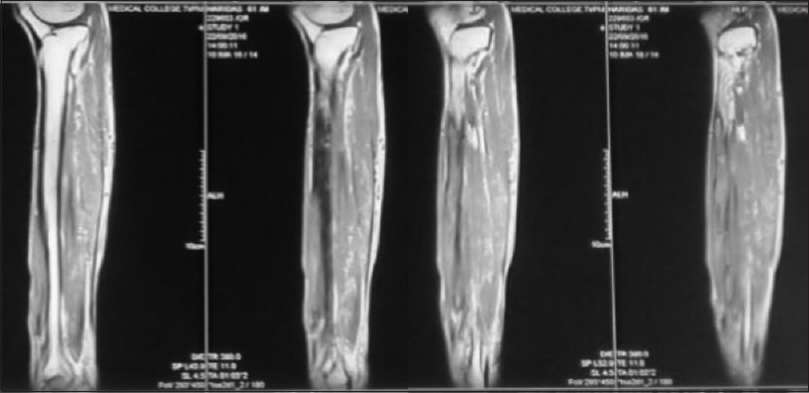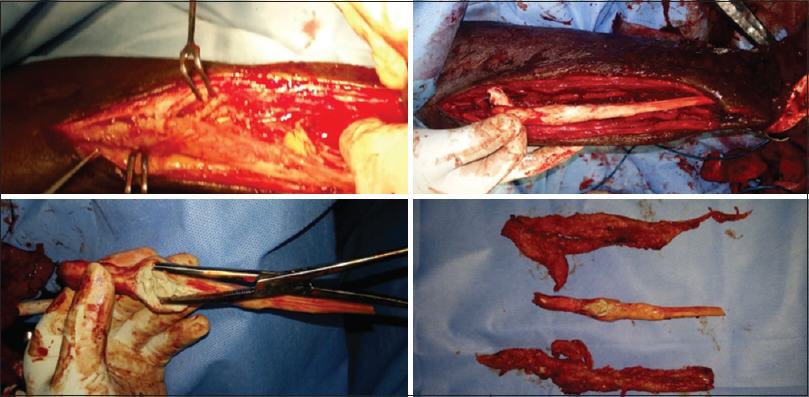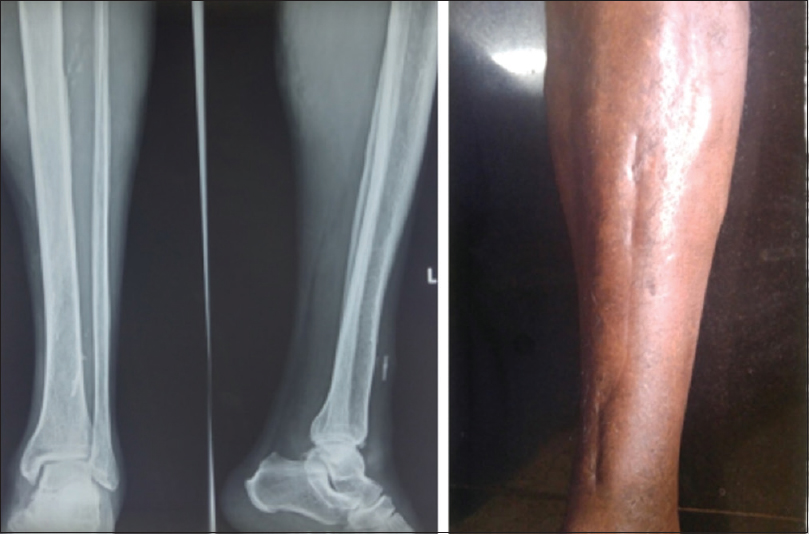Translate this page into:
A rare case report of osteomyelitis of myositis ossificans traumatica mass in leg
Address for correspondence: Dr. I. Ibad Sha, Department of Orthopedics, Government Medical College, Thiruvananthapuram, Kerala, India. E-mail: ibadshah47@gmail.com
-
Received: ,
Accepted: ,
This article was originally published by Wolters Kluwer - Medknow and was migrated to Scientific Scholar after the change of Publisher.
How to cite this article: Sha II, Edwin A, Roy S. A rare case report of osteomyelitis of myositis ossificans traumatica mass in leg. J Orthop Spine 2019;7:76-9.
Abstract
Myositis ossificans traumatica is a non-neoplastic proliferation of bone and cartilage tissue at the site of a previous injury. Osteomylitis of Myositis Ossificans Traumatica mass is even rarer and literature review show that this is only the second case reported till now. A 61 years old male presented to our outpatient department with main complaints of discharging sinus left leg for 7 months. Clinical provisional diagnosis of chronic osteomyelitis of left leg was made. Standard radiograph shows a large mass around the middle and lower third of left leg with osteomyelitic changes in the lower third. Magnetic Resonance Imaging confirm the diagnosis as Infectious Myositis mass. The patient got operated with complete excision of myositis mass and infected tissue. Post operative follow up shows complete healing with no recurrence. Osteomyelitis of myositis ossificans can be a possible differential diagnosis of chronic discharging sinus in cases were there is associated myositis mass adjacent to the lesion. Prompt diagnosis along with excision removal of mass and infected tissue should be the treatment to avoid recurrence.
Keywords
Anterior compartment leg
long-term sequelae
myositis ossificans traumatica
myositis ossificans
osteomyelitis
Introduction
Myositis ossificans (MO) traumatica (MOT) is an unusual complication following a muscle contusion injury. It is a nonneoplastic proliferation of bone and cartilage tissue at the site of a previous injury, most commonly after blunt trauma or repeated micro-injuries.[1] MOT of the lower limb is far less common compared to that of the upper limb.[2] Osteomyelitis of MOT mass is even rarer, and literature review shows only a single case report till now.[3]
Case Report
A 61-year-old male presented to our outpatient department with the main complaint of discharging sinus from the left leg for 7 months. The patient was properly examined with history taking and physical examination. History revealed an episode of trauma at the age of 12 years following a fall of log of wood, causing direct injury to his left leg. He noticed the thickness and swelling of his leg a few years later. The swelling was not interfering with his daily activities and hence was not bothered about the same. Seven months back, he developed fever along with pain over his left leg with a mild increase in the size of the swelling. He had treatment at a local hospital and took some painkillers and antibiotics. The complaints recurred 3–4 times, and he developed discharging sinus over his left leg for which curettage was done at a local hospital. Complaints persisted even after curettage, and hence he was referred to our hospital.
On physical examination, there was a discharging sinus from the anterolateral aspect of the distal third of the left leg with thickened edges [Figure 1]. The skin was puckered and thickened, and minimal tenderness was present. On palpation, the bone was exposed. Range of movements over the left knee and ankle were full and pain free. Vital signs of the patient were stable, and distal neurovascular status was intact. A clinical provisional diagnosis of chronic osteomyelitis of the left leg was made, and his blood examinations along with radiograph of the left leg were taken. Complete hemogram was done which was normal except for the raised erythrocyte sedimentation rate (Westergren's method = 45 mm/h).

- Image of the distal leg above the ankle showing discharging sinus with evidence of attempted curettage
A standard anteroposterior and lateral radiograph showed the entire femur and tibia which were normal, and there were no signs of osteomyelitic changes. There was a large mass around the middle and lower thirds of the left leg, with osteomyelitic changes in the lower third [Figure 2]. Radio-opacity of the mass was similar to a mature bone. The continuity of the mass with fibula was not well demarcated. Magnetic resonance imaging was taken to confirm the diagnostic report which came out as an infected myositis mass involving the anterior and lateral compartments of the leg [Figure 3].

- Preoperative radiograph anteroposterior and lateral view showing tibia and fibula along with myositis mass

- Preoperative magnetic resonance imaging pictures of the leg with myositis mass
After getting consent, the patient got operated with complete excision of the myositis mass and infected tissue [Figure 4]. Intraoperative examination of the excised mass was suggestive of a myositis mass [Figure 4]. Tissue removed was sent for biopsy, and the characteristic zonal phenomenon was identified on histopathological examination along with culture sensitivity. The postoperative period was uneventful [Figure 5]. Six-month follow-up shows complete healing with no recurrence [Figure 6].

- Intraoperative pictures showing the excised myositis mass

- Postoperative radiograph showing no residual myositis mass

- Radiograph and clinical images at final follow-up showing healed wound
Discussion
Posttraumatic MO can be seen at any age, but the highest incidence (50%) occurs in the third decade. Compared to adolescents and young adults, the incidence is very rare in the pediatric age group, especially below the age of 10 years, and only a few cases have been reported till now.[4]
Posttraumatic MO is the proliferation of bone and cartilage within a muscle after the formation of an intramuscular hematoma.[3] It is commonly seen as a complication of muscle contusions and strains following a major trauma or repeated injury.[5,6] The exact pathogenesis and etiological factors of bone formation in MO are still unclear.[5,7] It has been hypothesized that following a muscle injury, the rapidly proliferating mesenchymal cells under anoxic conditions cause differentiation of osteoblasts to produce ectopic bone and cartilage.[4,8] The tissue in the periphery of MO is the most prompt to repair, and it organizes and mineralizes into mature tissue. The center of the lesion will be progressively less differentiated.[7,8] This characteristic zoning helps to distinguish osteosarcomas from MO, with the former being the least differentiated at the periphery and most differentiated at the center.[4,7,8] MO usually shrinks as it matures over a 6–12-month period.[9] Maturation is characterized by a lack of pain and other local inflammatory changes. The peculiar clinicoradiological and cytological feature helps in the diagnosis.[10] The characteristic radiological and cytological feature of “zoning,” is due to a distinct mature ossification at the periphery and centrally situated radiolucent (which is due to immature osteoid and primitive mesenchymal tissue) nidus as mentioned earlier.[11]
The histopathologic appearance of the well-established lesion shows three areas of cellular maturation, presenting a characteristic “zone phenomenon” consisting of:
A central zone with nondifferentiated mesenchymal cells, without mitotic or morphologic abnormalities, but with a wildly proliferating fibroblastic pattern
An intermediate area containing osteoid substance
The external area with mature bone having osteolytic resorption.[12]
Another rare possibility like a calcified hematoma may be considered in a similar situation provided the presence of characteristic histological features such as the central zone of hemorrhage surrounded by dense fibrosis and hemosiderin-containing calcifications along with the absence of zonal phenomenon for diagnosis.[13]
Other than MOT, there are two variants called neurogenic MO (neurogenic paraosteoarthropathy) and fibrodysplasia (myositis) ossificans progressiva (FOP).
Neurogenic MO is rare and mainly involves the large joints of the body (hip and knee) following severe peripheral or central nervous system injuries. Its pathophysiology is unclear, but possible hypothesis includes venous stasis, associated with bone demineralization which may provoke calcium salt precipitation in nearby tissues.[8] Another postulate is microtrauma-induced endochondral ossification due to forced mobilization during nursing care and rehabilitation.[14]
FOP is predominantly seen in young age, is an autosomal dominant inherited disabling disease (a disorder of bone morphogenic protein 4), and has a predilection to the paraspinal, scalp, and temporomandibular joints (but never involves facial muscles, tongue, diaphragm, and viscera).[10,15]
MOT is generally considered a self-limiting condition and can have spontaneous resolution.[16] Ben Hamida et al. reported that full reabsorption can take place especially in lesions occurring within the muscle belly, whereas lesions located near an origin or insertion of a muscle are less likely to reabsorb and may result in functional impairment.[17] Parikh et al. reported that full reabsorption is more likely to occur in small, upper extremity lesions compared to a larger lesion located in the lower extremity.[18]
The management of MOT includes early conservative management with rest, immobilization, and physiotherapy.[10] Medical management by nonsteroidal anti-inflammatory drugs, particularly indomethacin and acetyl salicylate, has shown good results in MOT.[19,20] Other methods such as low-dose radiation therapy, acetic acid iontophoresis, and shockwave therapy have also been performed in many cases with positive results.[21] Surgical excision can be used as a last resort for the mature stage (6–12 months of trauma) to avoid the recurrence.[10,21] Surgery is reserved until approximately 12–14 months postinjury when the lesion becomes stable and the periosteum has formed.[19] Surgery is contraindicated for immature lesions due to the high recurrence rates.[5,21]
Regarding osteomyelitis of a myositis mass, literature demonstrate only one single case report where the lesion was on arm and presented with a discharging sinus which was treated with sequestrectomy.[10] In our patient, the osteomyelitis would have occurred possibly via a hematogenous spread. Classical features of chronic osteomyelitis such as initial pain and swelling followed by chronic discharging sinus were present. Lack of literature makes it difficult to evolve a consensus in this rare presentation, but from the previous case report as well as from our case, it can be concluded that excision of the infected myositis mass (similar to sequestrectomy) along with proper antibiotic treatment can be curative in this rare presentation.
In summary, as a rare case in literature, here we present the second case of osteomyelitis of MOT mass. In this case, MOT was in matured stage and infected, so the surgical excision was done. Clinicians should be aware of this unusual presentation of MOT in view of its rarity.
Conclusion
Osteomyelitis of MO can be a possible differential diagnosis of chronic discharging sinus in cases where there is associated myositis mass adjacent to the lesion. Prompt diagnosis along with excision of the mass and infected tissue should be the treatment to avoid recurrence.
Informed consent
Consent has been taken from the patient and can be provided if requested.
Declaration of patient consent
The authors certify that they have obtained all appropriate patient consent forms. In the form, the patient has given his consent for his images and other clinical information to be reported in the journal. The patient understands that name and initials will not be published and due efforts will be made to conceal identity, but anonymity cannot be guaranteed.
Financial support and sponsorship
Nil.
Conflicts of interest
There are no conflicts of interest.
References
- Current concepts in the development of heterotopic ossification. J Bone Joint Surg Br. 2004;86:783-7.
- [CrossRef] [PubMed] [Google Scholar]
- Myositis ossificans: A serious complication of a minor injury. CJEM. 1999;1:198.
- [CrossRef] [PubMed] [Google Scholar]
- Treatment of post-traumatic myositis ossificans of the anterior thigh with extracorporeal shock wave therapy. J Can Chiropr Assoc. 2011;55:240-6.
- [Google Scholar]
- Myositis ossificans circumscripta: A paediatric case and review of the literature. Eur J Pediatr. 2009;168:523-9.
- [CrossRef] [PubMed] [Google Scholar]
- Shock waves in the treatment of post-traumatic myositis ossificans. Ultrasound Med Biol. 2010;36:397-409.
- [CrossRef] [PubMed] [Google Scholar]
- Nonhereditary heterotopic ossification. Implications for injury, arthropathy, and aging. Clin Rev Bone Miner Metab. 2005;3:261-6.
- [CrossRef] [Google Scholar]
- Extra-osseous localized non-neoplastic bone and cartilage formation (so-called myositis ossificans): Clinical and pathological confusion with malignant neoplasms. J Bone Joint Surg Am. 1958;40-A:279-98.
- [CrossRef] [Google Scholar]
- Heterotopic ossification: Diagnosis and management, current concepts and controversies. J Spinal Cord Med. 1999;22:273-83.
- [CrossRef] [PubMed] [Google Scholar]
- Osteomyelitis of myositis ossificans in arm - First case report. J Orthop Case Rep. 2014;4:57-9.
- [Google Scholar]
- Reactive and metabolic conditions simulating neoplasms of bone. In: Dorfman HD, Czerniak B, eds. Bone Tumors. St. Louis: Mosby; 1998. p. :1139.
- [Google Scholar]
- Myositis ossificans in the soft tissues of the hand. Eur J Plast Surg. 1990;13(3):133-135.
- [CrossRef] [Google Scholar]
- Calcifying haematoma mimicking a soft tissue sarcoma and myositis ossificans. ANZ J Surg. 2006;76:1027-9.
- [CrossRef] [PubMed] [Google Scholar]
- Pre-surgical CT-assessment of neurogenic myositis ossificans of the hip and risk factors of recurrence: A series of 101 consecutive patients. BMC Musculoskelet Disord. 2016;17:433.
- [CrossRef] [PubMed] [Google Scholar]
- Myositis ossificans and the three-phase bone scan. AJR Am J Roentgenol. 1984;142:179-80.
- [CrossRef] [PubMed] [Google Scholar]
- Myositis ossificans circumscripta of the knee improved by alendronate. Joint Bone Spine. 2004;71:144-6.
- [CrossRef] [PubMed] [Google Scholar]
- The imaging features of post-traumatic myositis ossificans, with emphasis on MRI. Clin Radiol. 2002;57:1058-66.
- [CrossRef] [PubMed] [Google Scholar]
- Muscle injuries: Optimising recovery. Best Pract Res Clin Rheumatol. 2007;21:317-31.
- [Google Scholar]
- Heterotopic ossification: A review. J Rehabil Med. 2005;37:129-36.
- [CrossRef] [PubMed] [Google Scholar]
- The pathophysiology of heterotopic ossification: Current treatment considerations in dentistry. Jpn Dent Sci Rev. 2014;50:1-8.
- [CrossRef] [Google Scholar]






